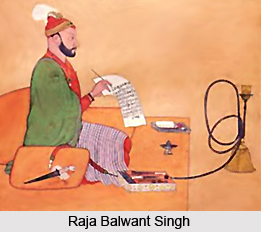 According to the history of Ghazipur District (that is known as Gadhipuri) this region was known as Garjpuri in ancient times. Eventually, it changed to Ghazipur and it was an important centre for British rule and it also played an important role in Indian National Movement. Interestingly, Ghazipur does not figure as such in ancient Indian History. Further, historical accounts state that Ghazipur District was covered with dense forests in Vedic era and it was a place for Ashrams of Saints during that period. This place is also associated with Ramayana period. Famous Rishis Gautam and Chyavan were given teaching and sermon here in ancient period. Lord Buddha gave the first sermon in Varanasi, which is not very far from here. The Aurihar area of Ghazipur District became the main centre for teaching of Lord Buddha. Many remnants and pillars are the main evidences of that period. Ghazipur District was an important centre during Buddhist period.
According to the history of Ghazipur District (that is known as Gadhipuri) this region was known as Garjpuri in ancient times. Eventually, it changed to Ghazipur and it was an important centre for British rule and it also played an important role in Indian National Movement. Interestingly, Ghazipur does not figure as such in ancient Indian History. Further, historical accounts state that Ghazipur District was covered with dense forests in Vedic era and it was a place for Ashrams of Saints during that period. This place is also associated with Ramayana period. Famous Rishis Gautam and Chyavan were given teaching and sermon here in ancient period. Lord Buddha gave the first sermon in Varanasi, which is not very far from here. The Aurihar area of Ghazipur District became the main centre for teaching of Lord Buddha. Many remnants and pillars are the main evidences of that period. Ghazipur District was an important centre during Buddhist period.
Moreover, the history of Ghazipur District says that this place was the main centre in medieval period from Sultanate period to Mughals. In Tughlaq period Muhammad Bin Tughlaq established Jaunpur as the capital under which Ghazipur was ruled. Further, in his regime, Syed Masood Ghazi established this town by defeating Raja Mandhata. In Lodi Period, Naseer Khan Nuhani was the administrator of Ghazipur who changed its conditions. This region was the main centre during Mughal period when Babur took over the charge of Ghazipur and Muhammad Khan Nuhani became its administrator. In the reign of Akbar, Afghan Ali Kuli Khan took over the charge of Ghazipur and developed the town Zamania. After the death of Aurangzeb this area was taken by Jamindar Mansa Ram. Thereafter, Ghazipur came under the sovereignty of Banaras state and Raja Balwant Singh, son of Mansa Ram became the king of Ghazipur. Ghazipur District came into being in the year 1818.
After the attack of Warren Hastings, the then Governor General of British rule, this area was ruled over by several British rulers. Ghazipur District played an important part in the freedom struggle of the country. This is the native land of several freedom fighters like Mangal Pandey. Famous Nilha Sahib Revolt is associated with this place where the farmers revolted against the British rulers. After the independence of the country, Ghazipur District could not develop as it used to be in the past.






